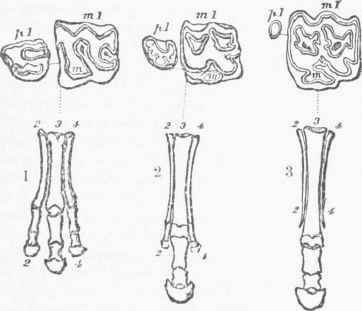Hipparion
Description
This section is from "The American Cyclopaedia", by George Ripley And Charles A. Dana. Also available from Amazon: The New American Cyclopędia. 16 volumes complete..
Hipparion
Hipparion , an extinct perissodactyl or uneven-toed mammal, belonging to the solidun-gulate (solid-hoofed or single-toed) division, which includes the horse and the ass, or the family equidoe. In its skeleton it was decidedly horse-like, but, in addition to the single toe on each foot, it had an additional one on each side, raised from the ground, and pointing laterally backward, as in the hog and ruminants.
The enamel of the molar teeth was in more complex folds than in the present horse. Fossil horse-like animals have been found in the later tertiary and quaternary of North and South America, Europe, and northern Asia, and especially in the western regions of the United States. This genus has been obtained from the later tertiary of Europe, Asia, and North America. Of the species described by Hayden, H. venustum, half the size of the ass, has been found in South Carolina; H. occidentale, speciosum, and affine, from the pliocene of Dakota and Texas, about the size of an ass, are all nearly allied, if not the same species. Pro-tohippus, hippidion, and merychippus are allied genera. - This series of horse-like animals is interesting from the point of view of the relation of past to present species, and of the derivation of the latter from the former; most naturalists of the present day, rejecting the principle of direct or miraculous creation, and recognizing a natural law or secondary cause, "the servant of predetermining intelligent Will," as Prof. Owen has it, as operating in the production of species in orderly succession and progression.
As proofs of the hypothesis that the existing are modifications of extinct species, changing by small degrees, it became important to collect a series of such intermediate forms from the fossil world. Prof. Owen, in his "Anatomy of Vertebrates," devotes a chapter to this subject, and especially mentions the series of anoplotherium, palaeo-therium, and hipparion, as supplying the links required by Cuvier to connect the pachyderms with the horse of the present day. In the accompanying illustration, p and m signify premolar and molar teeth, and 2, 3, 4 are the digits or toes. The palaeotherium had three nearly equal toes, each with a hoof; the hipparion was also in one sense three-toed, but the lateral hoot's were spurious, not touching the ground; and it is interesting to note that these three-toed horses arc found only in deposits of that tertiary period intervening between the older palaeotherium and the newer strata in which the modern horse first appears to have lost its lateral hooflets, and to have walked upon the end of the single second toe or digit, the two lateral splint bones being entirely internal and hoofless.
He makes the series, from the hoofs and molar teeth, paloeotherium, paloplotherium, ancitherium, hipparion, and equus (horse). To admit this does not require either the hypothesis of appetency or volition of Lamarck, the fitness of the surrounding medium of Geoffroy Saint-Hilaire, or the natural selection of Darwin; but simply the continuous operation of natural law or secondary cause, successively and progressively, " from the first embodiment of the vertebrate idea under its old ichthyic vestment, until it became arrayed in the glorious garb of the human form." (See Horse.)

1. Palaeotherium. 2. Hipparion. 3. Horse.
Continue to:


